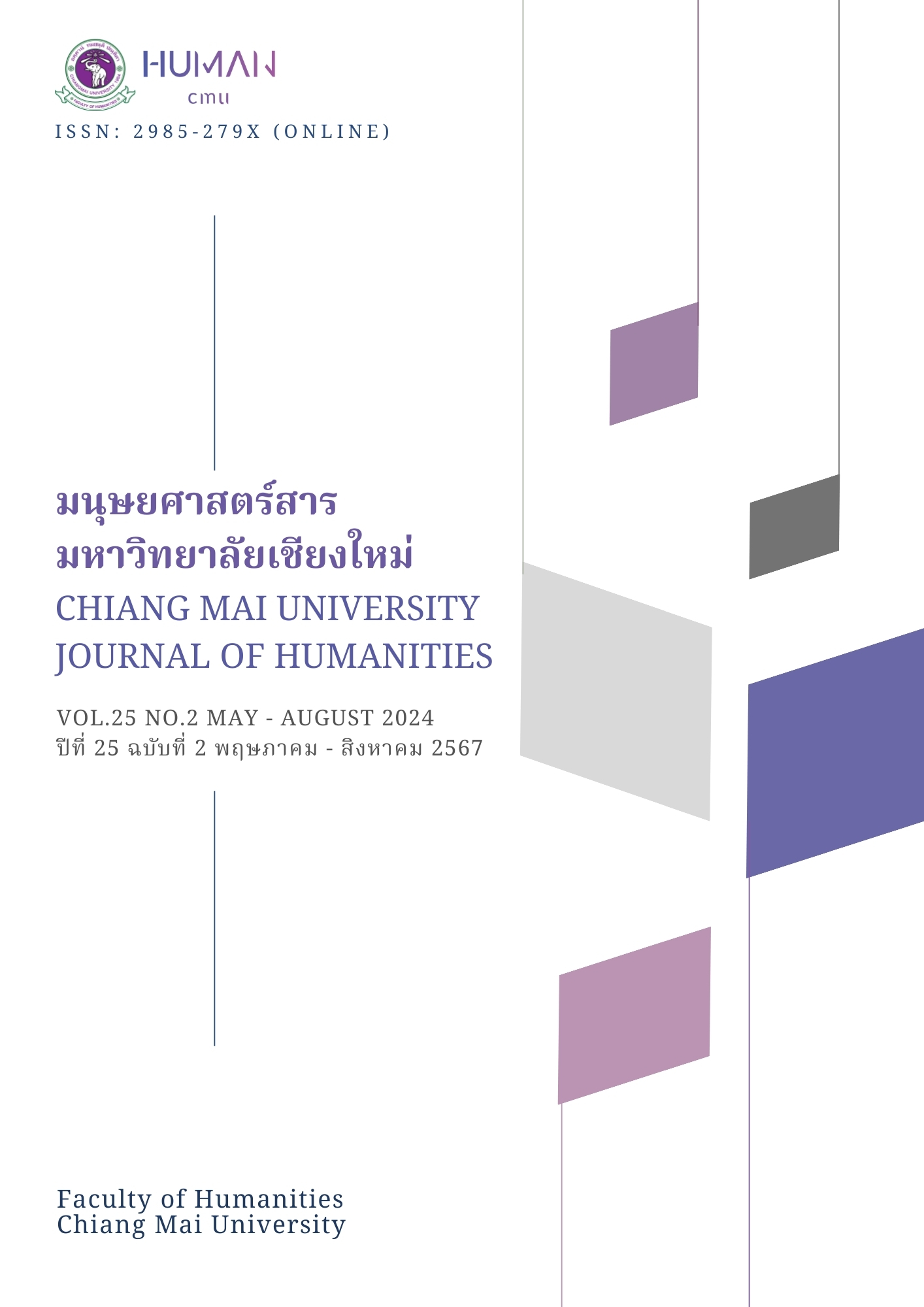องค์ประกอบการท่องเที่ยวและแนวทางการพัฒนา กรณีศึกษาชุมชนพวกแต้มในจังหวัดเชียงใหม่ ประเทศไทย
Main Article Content
บทคัดย่อ
งานวิจัยนี้มีวัตถุประสงค์เพื่อศึกษาองค์ประกอบการท่องเที่ยวของชุมชนพวกแต้ม และแนวทางการพัฒนาการท่องเที่ยวเชิงวัฒนธรรมของชุมชนพวกแต้ม งานวิจัยนี้เป็นการวิจัยเชิงคุณภาพ เครื่องมือที่ใช้ในการวิจัย คือ การสัมภาษณ์เชิงลึก รวมถึงการสนทนากลุ่ม ซึ่งผู้ให้ข้อมูลหลัก คือ ประชาชนผู้อาศัยในชุมชน กลุ่มผู้ประกอบการ และผู้ให้ข้อมูลหลักจากส่วนราชการที่เกี่ยวข้อง ทั้งนี้ได้สุ่มกลุ่มตัวอย่างโดยใช้วิธีการเลือกแบบเจาะจง ใช้วิธีการวิเคราะห์เนื้อหา ผลการศึกษาพบว่าองค์ประกอบการท่องเที่ยวของชุมชนพวกแต้ม ได้แก่ มีสิ่งดึงดูดใจทางการท่องเที่ยว คือทรัพยากรท่องเที่ยวด้านศิลปวัฒนธรรมประเพณี วิถีชีวิต มีเส้นทางคมนาคมขนส่งสามารถเข้าถึงแหล่งท่องเที่ยวในชุมชนพวกแต้มได้อย่างสะดวก มีสิ่งอำนวยความสะดวกเพื่อบริการนักท่องเที่ยวด้วย มีที่พักให้บริการนักท่องเที่ยว มีกิจกรรมการท่องเที่ยว มีการจัดการด้านความปลอดภัย มีการตลาดการท่องเที่ยว และชุมชนมีส่วนร่วมทางการท่องเที่ยว ส่วนแนวทางการพัฒนาการท่องเที่ยวเชิงวัฒนธรรมของชุมชนพวกแต้ม พบว่า ชุมชนพวกแต้มควรพัฒนาด้านแหล่งท่องเที่ยว โครงสร้างพื้นฐานของชุมชน กิจกรรมในแหล่งท่องเที่ยว ด้านความปลอดภัยในแหล่งท่องเที่ยวของชุมชน และพัฒนาด้านการตลาด เพื่อให้นักท่องเที่ยวได้รับประสบการณ์และความประทับใจจากการท่องเที่ยว ตลอดจนเป็นการสร้างงานและรายได้เสริมสร้างความเข้มแข็งให้แก่ชุมชน ส่งผลทำให้คนในชุมชนมีคุณภาพชีวิตที่ดี กระตุ้นให้คนในชุมชนมีจิตสำนึกให้เกิดการอนุรักษ์ทรัพยากรทางธรรมชาติ สืบทอดวิถีชีวิต และอนุรักษ์วัฒนธรรมท้องถิ่นไว้ให้คงอยู่อย่างยั่งยืนต่อไป
Article Details

อนุญาตภายใต้เงื่อนไข Creative Commons Attribution-NonCommercial-NoDerivatives 4.0 International License.
เอกสารอ้างอิง
Buhalis, D. (2000). Marketing the Competitive Destination of the Future. Tourism Management, 21(1), 97-116.
Buhalis, D., & Darcy, S. (eds.) (2011). Chapter 3 Accessibility: A Key Objective for the Tourism Industry. Accessible Tourism: Concepts and Issues. Channel View Publications, Bristol, United Kingdom.
Chiangmai Delight. (2019). khiao suai hom [เขียว สวย หอม]. Retrieved from https://www.chiangmaidelight.com/welcome/article_read/7.
Chittangwattana, B. (2006). kan phatthana lae kan anurak laengthongthiao [การพัฒนาและการอนุรักษ์แหล่งท่องเที่ยว]. Bangkok: Press & Design.
Chittangwattana, B., & Srikampha, P. (2014). kan phatthana kanthongthiao baep yangyuen (2nd ed). [การพัฒนาการท่องเที่ยวแบบยั่งยืน (พิมพ์ครั้งที่ 2)]. Nonthaburi: Thammasan.
Collier, A., & Harraway, S. (1997). Principle of tourism. Auckland: Longman.
Darcy, S., & Dickson, T. J. (2009). A whole-of-life approach to tourism: The case for accessible tourism experiences. Journal of Hospitality and Tourism Management, 16(1), 32–44. doi:10.1375/jhtm.16.1.32
Department of Cultural Promotion. (2016). ngan changfimue dangdoem: mondok phumpanya thang watthanatham khong chat [งานช่างฝีมือดั้งเดิม: มรดกภูมิปัญญาทางวัฒนธรรมของชาติ]. Bangkok: WVO Thai Printing.
Department of Tourism. (2014). khumue kan truat pramoen matthan khunphap laengthongthiao thang watthanatham [คู่มือการตรวจประเมินมาตรฐานคุณภาพแหล่งท่องเที่ยวทางวัฒนธรรม]. Bangkok: WVO Thai Printing.
Dickman, S. (1996). Tourism: An Introductory Text. (2nd ed). Australia: Hodder Education.
Esichaikul, R. (2014). kan chatkan kanthongthiao chapho thang [การจัดการการท่องเที่ยวเฉพาะทาง]. Nonthaburi: The Office of the University Press.
Green, G.P. (2001). Amenities and Community Economic Development: Strategies for Sustainability. Journal of Regional Analysis & Policy, 31(2), 61-75. doi:10.22004/ag.econ.132200
Kim, H., Cheng, C., & O’Leary, J. (2007). Understanding Participation Patterns and Trends in Tourism Cultural Attractions. Tourism Management, 28(5), 1366-1371. Elsevier Science Ltd.
Leiper, N. (1990). Tourist Attractions Systems. Annals of Tourism Research 17:367 384.
MacCannell, D. (1976). The Tourist: A New Theory of the Leisure Class. Berkeley: University of California Press.
Maxwell, J. A. (2013). Qualitative Research Design: An Interactive Approach (Applied Social Research Methods). Thousand Oaks, California: Sage Publication
Ministry of Tourism and Sports (in collaboration with Designated Areas for Sustainable Tourism Administration [Public Organization]). (2016). phaen yutthasat kanthongthiao doi chumchon yang yangyuen pho so 2559-2563 [แผนยุทธศาสตร์การท่องเที่ยวโดยชุมชนอย่างยั่งยืน พ.ศ.2559-2563]. Bangkok: author.
Nagarjuna, G. (2015). Local community involvement in tourism: a content analysis of websites of wildlife resorts. Atna Journal of Tourism Studies, 10(1), 13-21. doi:10.12727/ajts.13.2
National Tourism Policy Committee. (2016). ke kan phatthana kanthongthiao doi chumchon khong prathet thai [เกณฑ์การพัฒนาการท่องเที่ยวโดยชุมชนของประเทศไทย].
Retrieved from https://data.go.th/dataset/bcbd804e-aea8-4d8c-aa72-f87d431d22c6/resource/d4103ef8-e7b6-4540-9c31-d921a8099b8f/download/x-.pdf.
Office of the National Economic and Social Development Council. (2016). phaenphatthana setthakit lae sangkhom haengchat chabap thi 12 (pho so 2560-2564) [แผนพัฒนาเศรษฐกิจและสังคมแห่งชาติฉบับที่สิบสอง (พ.ศ. 2560-2564)]. Retrieved from https://www.nesdc.go.th/ewt_dl_link.php?nid=6422.
Office of the National Economic and Social Development Council. (2016). sarup sarasamkhan phaenphatthana setthakit lae sangkhom haengchat chabap thi 12 (pho so 2560-2564) [สรุปสาระสำคัญแผนพัฒนาเศรษฐกิจและสังคมแห่งชาติฉบับที่สิบสอง (พ.ศ. 2560-2564)]. Retrieved from http://www.nesdb.go.th/ewt_news.php?nid=6420.
Ongsakul, S. (2015). chumchon chang nai wiang chiangmai: prawatsat chumchon [ชุมชนช่างในเวียงเชียงใหม่: ประวัติศาสตร์ชุมชน]. Chiang Mai: Lanna Studies Centre, Faculty of Humanities, Chiang Mai University.
Organisation for Economic Cooperation and Development (OECD). (1994). The Contribution of Amenities to Rural Development. Paris, France.
Power, T.M. (1988). The Economic Pursuit of Quality. Armonk, NY: M.E. Sharpe, Inc.
Pretes, M. (1995). Postmodern Tourism: The Santa Claus Industry. Annals of Tourism Research 22:1-15.
Puak Team Samakkhi Community Committee. (2019). phaen chumchon phuak taem pi pho so 2562 [แผนชุมชนพวกแต้ม ปี พ.ศ.2562]. Chiang Mai: n.p.
Rabotic, B., Truisticka, V., & Strukovnih S., (2010, March). Tourist Guides in Contemporary Tourism. Proceedings Book of the International Conference on Tourism and Environment (ICTE), Philip Noel-Baker University, 353-364. Sarajevo, Bosnia & Herzegovina.
Samaraweera, K.G., & Upekshani, T.G.Y. (2019, December). An empirical analysis to investigate the influence of 5As on domestice tourists’ satisfaction in Hikkaduwa, Sri Lanka. Proceedings, South Eastern University International Arts Research Symposium -2019.
Séraphin, H., Platania, M., Spencer, P., & Modica, G., (2018). Events and Tourism Development within a Local Community: The Case of Winchester (UK). Sustainability, 10(10), 3728. doi:10.3390/su10103728
Sharpley, R. (2000). The Influence of the Accommodation Sector on Tourism Development: Lessons from Cyprus. International Journal of Hospitality Management. 19(3), 275-293. doi:10.1016/S0278-4319(00)00021-9
Social Research Institute, Chiang Mai University. (2019). chiangmai mueang hatthakam sangsan [เชียงใหม่เมืองหัตถกรรมสร้างสรรค์]. Retrieved from https://www.creativecitychiangmai.com/en/articles-en/chiang-mai-creative-city/.
Songsoonthorawong, C. (2018). nuai thi 2 sara lae boribot kiaokap kanthongthiao [หน่วยที่ 2 สาระและบริบทเกี่ยวกับการท่องเที่ยว]. In eksan kan son chut wicha watthanatham kap kanthongthiao [เอกสารการสอนชุดวิชาวัฒนธรรมกับการท่องเที่ยว]. Nonthaburi: The Office of the University Press.
Swarbrooke, J. (1999). Sustainable Tourism Management. New York: CABI.
Timothy, Dallebn J. (2011). Cultural Heritage Tourism: An Introduction. Bristol: Channel View Publications.
Tourism Authority of Thailand, Chiang Mai Office. (2018). aeo wiang chiang mai muan chai khanat [แอ๋วเวียงเจียงใหม่ม่วนใจ๋ขนาด]. Retrieved from
http://tourismchiangmai.org/th/event/eUsRQbiX6XbGwPup3LLdKb13BgfG2jgWmbyEnBCJ.
Wisetsunthonsakun, P., Na Thalang, C., Jittithavorn C., & Tungbenchasirikul, S. (2020). naeothang kan phatthana sakkayaphap kanthongthiao doi chumchon changwat nakhonratchasima [แนวทางการพัฒนาศักยภาพการท่องเที่ยวโดยชุมชน จังหวัดนครราชสีมา]. wansan kan wichai kan borihan kan phatthana [วารสารการวิจัยการบริหารการพัฒนา], 10(3), 22-33. Retrieved from https://so01.tci-thaijo.org/index.php/JDAR/article/.


